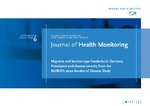Hinweis
Dies ist nicht die aktuellste Version von dieser Publikation. Die aktuellste Version finden Sie unter: https://edoc.rki.de/handle/176904/6963.2
Migraine and tension-type headache in Germany. Prevalence and disease severity from the BURDEN 2020 Burden of Disease Study
Porst, Michael
Wengler, Annelene
Leddin, Janko
Neuhauser, Hanne
Katsarava, Zaza
von der Lippe, Elena
Anton, Aline
Ziese, Thomas
Rommel, Alexander
Headache disorders are widespread among women and men in Germany and are primarily associated with restrictions
on quality of life. The two most common types of headache disorders are migraine and tension-type headache. In order
to gain valid estimates of the prevalence of these conditions, a cross-sectional telephone-based survey was conducted
among adults in Germany (N=5,009) between October 2019 and March 2020. The frequency, duration, the characteristics
and comorbidities associated with headache were measured using the diagnostic criteria defined in the International
Classification of Headache Disorders. 57.5% of women and 44.4% of men in Germany stated that they had had a headache
in the last twelve months. 14.8% of women and 6.0% of men meet all of the diagnostic criteria for migraine. Tensiontype
headache affects 10.3% of women and 6.5% of men. Migraine and tension-type headache are predominantly found
among people of working age and steadily decrease with age. Migraine is often accompanied by comorbidities such as
depressive symptoms and anxiety disorders. People affected by headache disorders tend to receive very little professional
medical care, with only a minority seeking treatment within a year. These results provide a comprehensive picture of the
population-related impact of headache disorders and are used in the BURDEN 2020 study to quantify key indicators for
burden of disease assessment.
Dateien zu dieser Publikation

